Text
Review: Guthrie Theater’s “Christmas Carol” constrains its characters
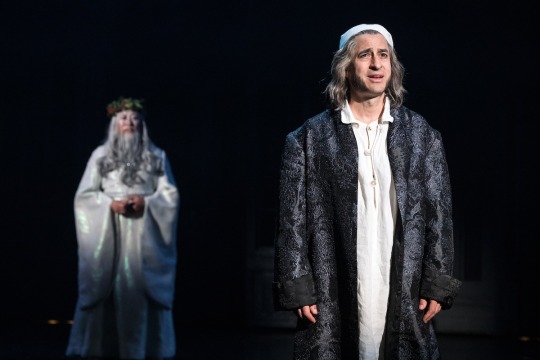
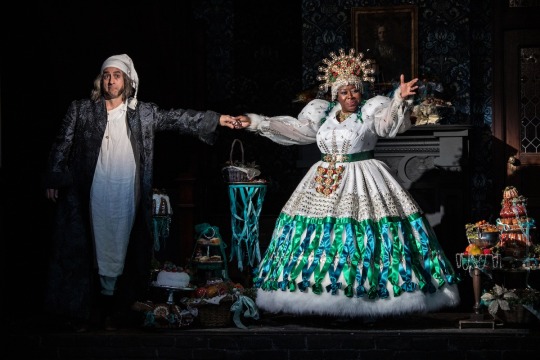
I suspected my mom would have one question about this year’s production of A Christmas Carol at the Guthrie Theater: Does the turkey trot?
Fifteen years ago, the Fezziwigs’ onstage party was so riotous, a roasted fowl was produced and “the darn turkey causes an uproar by hopping off the table,” my mom wrote in a 2008 review for the Twin Cities Daily Planet. “It runs around the stage several times and exits stage left.”
Director Gary Gisselman’s Christmas Carol was chockablock with physical humor and treated Scrooge’s journey broadly, playing to the peanut gallery (as the headline on that 2008 review put it). The Guthrie added some discipline in 2010, commissioning a new script from Crispin Whittell for a rendition that, with various edits over the course of its decade-long run, came increasingly to focus on the spirit of the story and its social conscience.
The current Christmas Carol was adapted from Charles Dickens’s 1843 novel by Lavina Jadhwani, in a script that debuted in 2021 with artistic director Joseph Haj at the helm. This year, Addie Gorlin-Han directs the show, though Haj retains a “based on the original direction” credit.
This was my first year seeing the Guthrie’s post-lockdown Carol, and it was moving just to browse the program: the cast is full of familiar names, taking regular Twin Cities theatergoers on their own journeys of memory — not only to previous Guthrie productions, but also to the stages of Penumbra, Mixed Blood, and even Theatre de la Jeune Lune.
While I’m not particularly nostalgic for the era when Fezziwigs’ prank turkey was followed by a scene where a prop dog ran amok on the streets of London (“chasing an unfortunate soul out the same exit where the turkey disappeared,” noted Mom), the current Carol left me thirsty for just a bit of the character humor that this material lends itself to.
read more
14 notes
·
View notes
Text
Screening next month at the Walker Art Center, because one of Minnesotans' most endearing qualities is our endless appetite for British supermarket ads.

Sociologists caution against reading too much into a society’s cultural products, be they books or banner ads, but it’s impossible not to see each year’s selection of British Arrows award-winning ads as a barometer of the masses’ mood.
When the annual parade of video spots first gained Stateside popularity through holiday season screenings at the Walker Art Center in Minneapolis, British humor was a principal draw. Side-splitting ads have remained part of the mix, but over the decades the program has become more wide-ranging. The internet became a major medium, digital effects became routine, and onscreen representation of the nation’s diversity increased dramatically.
There’s also been a gradual deflation of the optimism following the end of the Cold War. Hot wars, global warming, resurgent authoritarianism, and the coronavirus pandemic have all contributed to a more somber mood among consumers. In marketing circles, authenticity and transparency have become watchwords for companies hoping to convince consumers they’re committed to an open and honest relationship in these challenging times.
This is all to say that this year’s British Arrows are a little moody, conveying the sense of a capitalist economy where we’re all holding hands but we can’t say whether it’s out of genuine attraction or sheer panic.
read more
44 notes
·
View notes
Photo

What is TÁR? Why is everyone talking about it? Is this Cate Blanchett's greatest work since Carol? Be one of the first in Minnesota to find out: grab a free pass for a Monday screening at Showplace ICON.
5 notes
·
View notes
Text
Catch Julia at the Lagoon.
Documentary “Julia” Cheers for Child

During a montage of media appearances, Julia features a clip of Chef Child with Fred Rogers, making spaghetti Marco Polo in 1974. There, together on screen, are two 20th century icons that have fascinated the 21st century. As so many idols have fallen, from Michael Jackson to J.K. Rowling, Mr. Rogers and Julia Child have remained beloved figures who become more, rather than less, impressive the longer and more closely their lives are examined. Maybe add Bob Ross to the list.
That said, when the new documentary strains to argue that Child remains under-appreciated, it’s a lift. Child (1912-2004) was perhaps the most famous cook in American history, a woman whose name became synonymous with ambitious but accessible recipes. It’s a commonsense that she rescued the postwar United States from T.V. dinner purgatory and paved the way for the surfeit of food programming that fills cable channels and streaming services today.
The fact that deserves to be more widely appreciated, as filmmakers Julie Cohen and Betsy West note, is that Child didn’t step before a television camera until she was in her 50s. In an era of growing awareness of age discrimination, Child is dramatic proof that you can start an entirely new career at midlife and enjoy decades of successful work. She also stood apart for the complete confidence she brought to the screen despite an outsize physical presence that no one at the time would have written on a casting sheet. Indeed, a quality that gratifyingly comes through both in the film and in the Bob Spitz biography on which it’s partially based is Child’s sensuality. Her beloved husband Paul was a skilled photographer, and Julia includes a glance at an intimate nude portrait that suggests the lasting warmth the seemingly unlikely pair shared.
Julia Child wasn’t one to make love to her food, though: she handled it with respect but without kid gloves, showing her millions of viewers that it was okay to make mistakes. Julia opens with Child introducing “the chicken sisters,” their raw corpses lined up unceremoniously as the cook knights them with her knife. “Miss Broiler! Miss Frier! Miss Roaster! Miss Caponette! Miss Stewer, and Old Madam Hen.” The filmmakers intercut Child’s vintage clips with fresh footage of food shot up-close in the style of more contemporary cooking shows; the approach is a little distracting, but does serve to remind us that Child’s tutelage helped Americans achieve much more palatable results than many were used to seeing in the heyday of casseroles and Jell-O salads.
The film, which draws on interviews with Child’s family members, friends, and latter-day peers, covers a lot of ground in 95 minutes. That keeps it brisk, but also a little cursory; this is definitely Julia Child 101, but it’s an accessible introduction to the life and work of a culinary pioneer.
– Jay Gabler
14 notes
·
View notes
Text
Reimagined “Oklahoma!” Hints America Is Not O.K.

Director Daniel Fish’s radically reimagined production of Rodgers and Hammerstein’s Oklahoma! was originally workshopped in 2015; after a Tony-winning Broadway run, a national tour officially opened last night in Minneapolis, where it’s playing through Sunday. 2015 feels like a billion years ago, but that eon has only increased the resonance and relevance of a show that dramatizes the deadly consequences of aggrieved, entitled masculinity in a nation full of firearms.
While Thursday’s crowd at the Orpheum Theatre rose to cheers — and, in some cases, to their feet — for boisterous numbers like the exuberant actor Sis’s lusty rendition of “I Cain’t Say No,” the audience was also clearly challenged by the production’s deliberately disorienting zigs and zags. (The crowd’s demographics were predictable for a touring Broadway classic: in their masks, half the men could have passed for Governor Tim Walz.)
With a quick-step flow that disrupts expectations for stagy applause invitations, the production alternately presents itself as a modestly refreshed revival, a campy singalong, and a subversive reinvention. The final scene lands firmly on the latter note, with a rendition of “Oklahoma” bleaker than one might have imagined at the opening of Act II, let alone before stepping into the theater.
It’s a pointed challenge to the many culturally complacent productions that have come before, but it also has the effect of shaking the dust off one of the most influential works of American art ever created, reclaiming Oklahoma! as a product of the modernist era. The dream ballet, for example, becomes a showcase for solo dancer Gabrielle Hamilton, who dramatizes the pained undercurrents of a community where men just cain’t stop fighting over women.
The show’s top note is a spicy one, apparent from the outset as Curly (Sean Grandillo) turns his silly song about a surrey into a slow-burning seduction that’ll singe your chaps. Before that, though, he unfurls the iconic “Oh, What a Beautiful Mornin'” with blithe, unhurried polish as the rest of the cast lounges dispassionately at tables laden with cans of cheap beer. It may be a beautiful mornin’ for the cock of the walk, the show implies, but a sense of menacing malaise is also afoot.
The production’s most fascinating aspect is the nimbleness with which Fish flips the script — which, in a literal sense, remains unaltered from the original text. Not every classic musical could take this kind of stress test; a recent revival of Paint Your Wagon, for example, tossed the original book entirely to recast the songs in a more palatable context. In the case of Oklahoma!, though, the script by Oscar Hammerstein II shines all the more when cast in a new light. Fish and his diverse cast surface an itchy, randy energy that’s refreshingly sex-positive. Ado Annie cain’t say no…nor does she need or want to.
This interpretation even finds a current of lust between farm girl Laurey (Sasha Hutchings) and hired hand Jud, played by Christopher Bannow as a stringy-haired, unshaven, eerily calm outsider who’s visibly ready to ensure that any and all of the “intentionally staggering” number of guns that appear onstage in the first act go off in the second. He’s not the only one bringing a gun to town, though, and the show’s most challenging choice is to implicate happy hero Curly as complicit in the community’s culture of toxic bravado.
That all makes the show sound like a heavy slab of message, but in fact it may well be the most entertaining Oklahoma! you’ll ever see. The cast fill Laura Jellinek’s brightly wood-paneled, banner-festooned set with effusive energy that’s all the more involving for being cast in an ironic light. The show’s music is performed by an onstage Americana ensemble, giving the timeless songs a gratifyingly period-specific flavor while cautiously guarding against the encroachment of nostalgia.
Not everything works, and that’s fine. When it comes to a technique involving a blackout and closely-miked dialogue, a little bit would have gone a long way; instead, we get a lot. On Thursday the cast seemed to be still finding the show’s rhythm — and, perhaps, adapting to the strange energy of a nervously vaxxed live audience. If they didn’t nail every beat, though, the beats were there. The difference in this production is that, for perhaps the first time in the long history of this well-worn musical, we can also hear the off-beats.
– Jay Gabler
Photo by Matt Murphy for MurphyMade, courtesy Hennepin Theatre Trust.
30 notes
·
View notes
Text
Theatre Pro Rata Brings Shoulderpads-Era Caryl Churchill to the Crane Theater With “Top Girls”

“You’re a sexist, egotistical, lying, hypocritical bigot!”
Even acclaimed playwright Caryl Churchill had her work cut out for her trying to match 9 to 5 screenwriters Patricia Resnick and Colin Higgins in lucidly critiquing ’80s workplace sexism, but it always needs to be said once more for the people in the back.
Theatre Pro Rata embrace the Thatcher-era setting of Churchill’s Top Girls (1982) in a focused, humane new production at the Crane Theater — a venue that recently played host to the Twin Cities Horror Festival, so its black matte walls are absorbing plenty of dread this season.
With contemporary music setting the scene and performers costumed (by Eleanor Schanilec) in outfits that evoke the times without condescending to played-out leg-warmer stereotypes, director Carin Bratlie Wethern turns the clock back four decades to an era of British history where anyone who’s been absorbing this year’s copious Princess Di content has been spending a fair amount of time.
The play, which in many assessments sits near the top of the prolific playwright’s lauded oeuvre, centers on Marlene, played by Maggie Cramer with subtlety and conviction. Marlene’s recently been promoted to head of the Top Girls employment agency, where she not only needs to navigate her own career and the choices she’s made in prioritizing her work, but also guide a steady stream of women looking to land better positions for themselves.
Marlene and her agents (Megan Kim and Nissa Nordland Morgan) err on the side of brutal honesty when counseling applicants about realities including ageism and the dangers of letting prospective employers know too much about your plans for having a family. The seemingly hard-headed Marlene does have broader reflections on the injustice of it all, though, as we learn in a famed opening scene in which legendary women convene in her imagination for a wine-thirty dinner party.
Wethern’s strong ensemble cast carries this scene, as well as the others, with perfect aplomb. Sarah Broude heads the table as the iconic Pope Joan, while Emily Rosenberg’s badass Dull Gret uses her few words well. Ninchai Nok-Chiclana, who’s kept hopping as a server keeping the thirsty ladies’ wine glasses filled in the opening scene, later shines in two additional roles: a frank child and a job-seeker with a particularly creative résumé.
The show’s powerful concluding scene is a family reunion as Marlene visits her sister Joyce (Kelsey Laurel Cramer, convincingly weary) and niece Angie (Rosenberg, grippingly enthusiastic). While the opening scene underlines the universality of patriarchal oppression, the final scene feels very specific to its place and time, including the suggestion that the upwardly mobile Marlene has succumbed to yuppie conservatism. Today, you’d imagine the rural Joyce being an anti-vaxxer who blows up over Marlene allowing Angie to get a poke of AstraZeneca during her London visit.
If you’re vaccinated yourself (cards are checked at the door), this accessible, absorbing production is ample reason to pause the endless content stream and check in again with thought-provoking live theater. It still feels thrillingly novel to see people together onstage again, and this top-notch Top Girls cast make the most of the opportunity.
– Jay Gabler
Photo: Maggie Cramer in character as Marlene (Charles Gorrill, courtesy Theatre Pro Rata).
7 notes
·
View notes
Video
youtube
Blue Bayou is a heart-rending new film starring Justin Chon and Alicia Vikander, based on the true stories of legally adopted Americans who are being deported. See it early (and free!) at a special Rosedale screening next Wednesday, September 15.
18 notes
·
View notes
Video
youtube
🎬 Paul Schrader
♥️♣️♦️♠️ gambling
🔥 Oscar Isaac
What more do you need to know? Grab a pass to see The Card Counter early — and free! — in romantic Roseville on September 7.
3 notes
·
View notes
Text
Theater Review: The Birth Play Project’s “Aquelarres” Brings Strange Magic to the Open Air
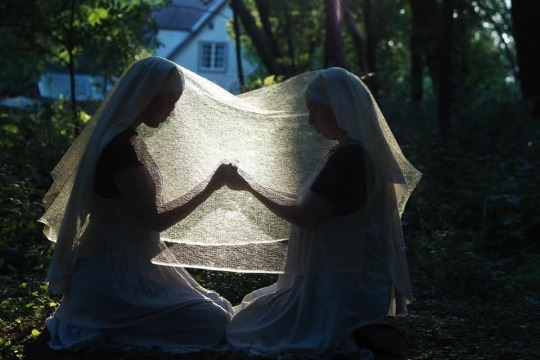
Aquelarres certainly explores the space. Staged on a verdant hill behind Edgcumbe Presbyterian Church in St. Paul’s Highland Park neighborhood, the production alternately has actors huddling at one end of the space, wailing at the other, dodging behind trees, gathering on a platform, running around the audience, and wandering through the woods. Depending on where you sit, you’re bound to miss at least a few lines of the unamplified dialogue, particularly given the competition from birds, crickets, and the sounds of summertime revelry drifting in from nearby parties.
Director Madeline Wall’s world premiere production of Joel F. Wilshire’s play, presented under the auspices of The Birth Play Project, is certainly invested in its distinctive milieu. Unfortunately there’s not much else for the audience to invest in, given a long and sometimes stilted script that waters down the magic as characters exchange long passages of urgent dialogue that fail to shed much light on the deeply confusing plot.
The story unfolds along two tracks. A pair of witches (Anya Naylor and Antonia Perez) from a struggling coven hatch a plan to supplicate an ancient god (played by the ensemble as a large puppet with a striking head designed by Robert McGrady with other members of the creative team). Meanwhile, a mysterious young women (Dariana Elise Pérez) seems to perish in the exploitative custody of the local governor (Seth Campbell) and appears to a terrified pair of nuns (Mel Fellows and Olivia Kemp) with ghostly instructions regarding the disposal of her uncorrupted remains.
The play was inspired by the eponymous paintings of Francisco de Goya, and it wears that inspiration like a heavy cloak, with the Moon (Katelyn Tseng McLane) referencing the unseen artwork to set a scene for each of the three acts. There are some striking tableaus as the production descends into darkness (Thursday night’s performance ran to 9:45 p.m.), but the outdoor setting presents real challenges for the cast — sometimes quite distant and dim — to build characterization and drop the exposition the show relies upon.
A few of the actors nonetheless succeed at leaving strong impressions. That includes Antonia Perez, whose character spikes her mythopoetic dialogue with pungent f-bombs; Mel Fellows as an amusingly nervous nun; and a literally haunting Dariana Elise Pérez, who retains her poise even after getting dragged around the glen on a sheet. The villainous Campbell gets an odd comeuppance in a ritual that owes equally to Goya and Xavier Roberts.
Though uneven, Aquelarres marks a welcome stage in the gradual return of live independent theater in all its wonderful weirdness. On Thursday night Wall and Wilshire laid out a tarp and sat on the ground among the audience, watching their creation unfold as the sky dimmed and the footlights burned on.
– Jay Gabler
Photo by Shane Morgan
3 notes
·
View notes
Video
youtube
Fresh off a Best Director win at Cannes, here’s your chance to see Annette before anyone else in Minnesota. Enter to win a pass for an early screening on August 4, before the movie opens in theaters August 6.
4 notes
·
View notes
Text
Theatre Elision Finds Safe Harbor With “Islander”
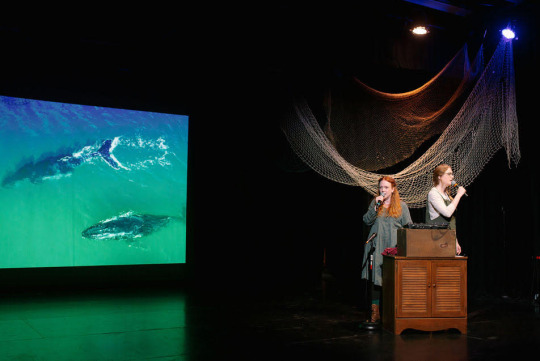
Last night in the lobby of the Elision Playhouse, I ran into a friend and we shared a quick hug. I apologized for being sweaty, having just hopped off my bike.
“It’s okay,” she said. “You’re human!”
It’s starting to feel that way again. We were at the Crystal venue to be part of one of the first audiences for professional theater to be conventionally staged — that is, on a stage inside a theater — in Minnesota in well over a year. I’ll confess to feeling a little emotional about that fact as the lights went down, but then the actors emerged and there was a story to tell.
No simple story, at that. Islander, described by creator Amy Draper as “a devised a capella musical for two actresses,” emerged in Scotland in 2017 and finds its young protagonist Eilidh facing challenges ranging from boredom to displacement to death (both human and cetacean) when a mysterious new friend named Arran lands, sopping and shivering, on the “wee isle” Eilidh calls home.
The show is presented with a rotating cast; I saw Christine Wade as Eilidh and Emily Dussault as Arran. (Deirdre Cochran plays Arran at many of the performances, which run through July 31.) The two-hander becomes multi-vocal not only as the performers flip fluidly through the island’s mixed deck of characters, employing gradations of accent that would give even Streep grief, but through an onstage looping board that allows the singers to create their own backing tracks as the show progresses.
It’s a neat trick and no mean feat for the actors, who carry the show confidently under the direction of Lindsay Fitzgerald. Wisely, the songs by Finn Anderson (Stewart Melton wrote the book) are deployed to strong narrative, and often lightly comic, effect. In rhythmic lines that sometimes verge on rap, the songs dramatize exchanges among characters at such occasions as an island meeting where the residents try to get past the lingering mystery of what happened to one man’s stolen garden gnome. The music has the effect of highlighting just how close the characters’ lives are despite their differences.
Islander covers a lot of ground in its single 75-minute act, and to the creators’ credit it doesn’t strain for a tidy resolution to the pain in Eilidh’s family and community. (I won’t even try to explain how Arran’s arc gets resolved, except to say that it takes the practice of water birth to a whole new level.) In the end, the plot is less important than the atmosphere the production conjures, replete with projections of atmospheric aerial photography. The actors’ humane and deeply connected performances effectively highlight the material’s more down-to-earth aspects, without getting lost in the mythological mists that constantly beckon.
At the end of the show there was a standing ovation; it was well-earned by the committed actors and their production team, but as Dussault and Wade turned to exchange relieved grins there was a sense that they were also receiving applause on behalf of the thousands of local theater artists who’ve endured the profoundest of barriers to practicing their craft over the past sixteen months. Now they’re back, and their characters’ special handshake — where each girl grasps her own hands, standing at a distance from the other — is just an inside joke. If they’d wanted, they could have hugged.
– Jay Gabler
3 notes
·
View notes
Text
British Arrows Greatest Hits bring welcome warmth via the Walker Art Center

“I thought they were going to be depressing,” my partner said with relief when our preview screening of the British Arrows Greatest Hits wrapped up.
Her concern wasn’t unfounded: the Arrows, formerly known as the British Television Advertising Awards, have had some harrowing years as the U.K. ad industry honors public service announcements designed to increase seatbelt usage, or inspire donations for cancer research, or reduce the prevalence of knife fights (an almost quaint aim from the perspective of the gun-crazy United States).
This year, though, the Arrows have reached into their archives for 80 minutes of nearly pure pleasure: a selection of funny and warm, or at worst wistful, clips from the awards’ multi-decade history. The Walker Art Center has long had a close relationship with the Arrows, teaching generations of globally-minded Minnesotans to make the annual screenings an Anglophilic holiday tradition.
With everything disrupted, this year the Arrows are going virtual, and the Walker’s Virtual Cinema is streaming the Greatest Hits from November 19 through January 4. At $12 per household it’s an easy choice to replace a night watching whatever Netflix coughs up for Christmas.
This isn’t the first year the Arrows have plumbed their vault; for the awards’ 30th anniversary in 2016, the presentation opened with a chronological presentation of past highlights, a few of which are reprised once again here. (You wouldn’t want to omit the iconic Cadbury gorilla.) This year, though, the calendar goes on shuffle as we zing back and forth across the years to enjoy some of the most creative, heart-warming, eye-popping ads to ever have been honored.
The resulting presentation hits all the pleasure centers that Arrows fans have learned to prime. There’s the comically reverent beer ad (a 2002 spot for Stella, natch), the special effects spectacular (a 2007 clip for Bravia that doused an entire housing complex in splashes of liquid color), the cute animal clip (remember #DancePonyDance, from 2013?), the historical pageant (a 2009 mini-film in which a boy carries a loaf of Hovis through the entire 20th century), and of course a John Lewis Christmas advert (this one from 2012, with an eye-moistening twist ending).
If you’re an Arrows regular, of course you’ll find that one of your favorites has been omitted (I’ll forever stan the PG Tips sock monkey), but you’ll also be reminded of a classic you’d forgotten (He-Man and Skeletor dancing dirty, anyone?). Warning: you’ll also be reminded that flash mobs used to be a thing.
The presentation concludes with a handful of ads made in recent months, during distancing compelled by the coronavirus pandemic. Needless to say they’re creative and charming, but the best of them has Snoop Dogg gyrating on a packed dance stage while he raps about the food delivery service Just Eat — a poignant reminder that what we’re bound to be most nostalgic for this holiday season is the ability to be together in real life.
Until we can do so safely, though, screens will have to suffice, and if anyone knows how to make good use of screen time, it’s the people who have to pay £1,000 a second for it.
– Jay Gabler
24 notes
·
View notes
Photo

Pow Wow Grounds is accepting donations to feed community members on Franklin Avenue. So proud of, and grieved for, our strong South Minneapolis community.
7 notes
·
View notes
Video
youtube
Murder! Fish! Small-town secrets! Did we mention SEX??? It’s called Blow the Man Down, it arrives on @primevideo March 20, and you can see it early for free on 3/18 at the Lagoon because you follow the right blog. Download passes here.
0 notes
Text
“Ancient Caves” at the Science Museum of Minnesota’s Omnitheater Sets a New Low (In a Good Way)

Ancient Caves. A journey hundreds of feet below the earth, into palatial caverns and underwater forests of translucent crystals, captured in immersive visual splendor. You’re in, right? You don’t need a reason to go.
Um, yes you do. This is science.
The reason for paleoclimatologist Gina Moseley’s descents, we learn in Ancient Caves, is to gather data about past changes in the earth’s climate. Specifically, in the stunning new film opening today at the Science Museum of Minnesota’s Omnitheater, she’s researching the question of how rapidly sea levels rose during past warming events. As narrator Bryan Cranston points out, this is not unrelated to the question of what we can expect in our planet’s very near future.
Ancient Caves is a triumph for the format, delivering both truly rare visual wonders and the kind of deliberate, substantive scientific education that hasn’t always made it through the cute-penguin montages and helicopter-over-the-waterfall shots of past dome films. That’s a credit to director Jonathan Bird, but it also speaks to the reach of the new digital equipment that was used to shoot the film.
Certain shots in the film could never have been achieved using traditional film cameras, executive producer Mike Day told me before a preview screening this week. When you see the film, it’s obvious why: spelunkers are shown squeezing through almost prohibitively tight spots as they descend through a warren of stunning spaces in the Bahamas’ Crystal Caves of Abaco.
The film is also projected digitally, which means you won’t hear the familiar putt-putt-putt-whirring of the giant projector starting up at the beginning of the film. The Omnitheater’s new “Laser Dome” digital projection system, years in the making, delivers superior image quality and gives the museum greater flexibility.
Both the groundbreaking projection system and Ancient Caves itself, in which the Minnesota museum was a production partner via the Giant Dome Theater Consortium, are testament to the Science Museum’s leadership role in the community of institutions with the capability to deliver experiences like this. Between the Laser Dome and the sleek planetarium at the new Bell Museum, Minnesotans in the Venn diagram overlap between dome screen fans and science lovers have never had it better. (You know who you are.)
In Ancient Caves, Minnesota even gets to see a bit of itself. Moseley, the Austria-based, star of the film, collaborates with University of Minnesota geochemist Larry Edwards to analyze her samples — so we get some sweeping shots of the West Bank in Minneapolis along with a brief descent into a cave that lies beneath southeastern Minnesota farmland.
At a time when it seems like everything is awful and getting worse, Ancient Caves is a welcome oasis of wonder and hope in the context of clear-eyed science. Shot with sweep and style, it’s a reminder that earth still holds uncharted wonders — and that it’s our job to preserve them, in part so we can learn more about how to preserve the more mundane but no less precious wonders we enjoy every day.
– Jay Gabler
12 notes
·
View notes
Photo

An Art of Changes brings a lifetime of Jasper Johns prints back to the Walker Art Center.
77 notes
·
View notes
Text
USPTO denies "vegan butcher" trademark to indy food shop, then gives it to Nestlé
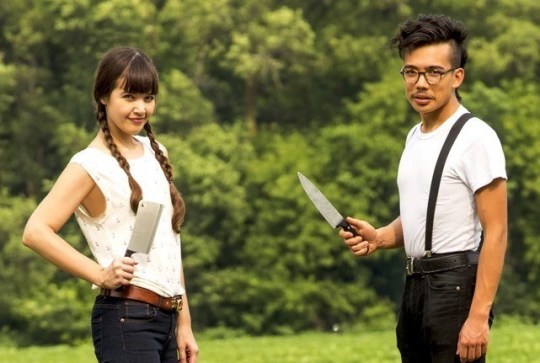
Aubry and Kale Walch run a vegan specialty food shop, called The Herbivorous Butcher in Northeast Minneapolis. In 2017 they applied to trademark the term “Vegan Butcher” with the U.S. Patent and Trademark Office. Their application was denied, reports Business Journal. The USPTO told the Walches that the term was ineligible for a trademark because it was “merely descriptive.” But when Nestlé later applied to trademark the same term, the USPTO granted it to them.
The Walches are challenging the decision. According to Business Journal, they “say they’re trying to either get to keep using the phrase or to keep it in the public domain so that any business can use it. The case is entering the discovery phase and will go before an administrative panel next.”
https://boingboing.net/2019/11/26/uspto-denies-vegan-butcher.html
154 notes
·
View notes